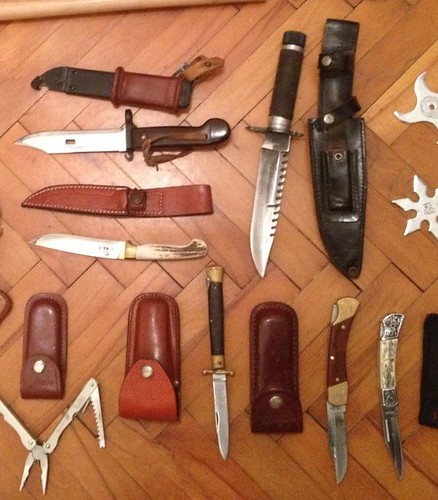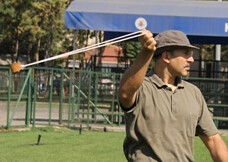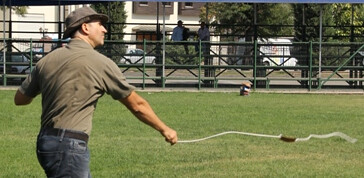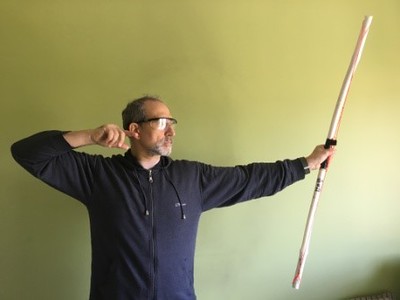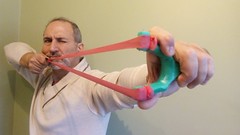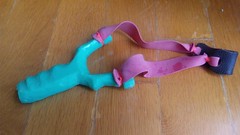 The Ultimate Survival Weapon-Part 2: Sling, Slingshot and Pellet BowDr. Murat Özveri A survivor in a jungle with a multi-purpose knife in the hand is a good-looking Hollywood-cliché. The industry makes it look good: Great make-up, excellent costumes, “magical” survival tools! In 1990s knives with bowie-blade with a saw-edge were introduced as the “ultimate survival tool”, especially because of the wind created by “First Blood” by Sylvester Stallone. These beautiful knives had a hollow grip in which there were hook and string for fishing, matches, first-aid kit, etc. Who can forget the scene in which Rambo put surgical sutures on his own wound? In 2000s, knives with plastic ergonomic grips and shorter blades in drop-points shape became popular. Any knife would be a treasure in survival situations. I have one of those “Rambo knives” in my collection but I rarely took it with me when I go to woods. There are more efficient and user-friendly designs that an outdoor man or a survivor would prefer. Serious and rational survival books emphasize the importance of the mental attitude rather than the tools. It is said that creating and maintaining a positive attitude is the most important thing. Some pray, some stick to the thought of being back to their families and beloved ones, but the mental aspect is all what makes the difference between death and life. Some experts claim that one can survive even with a simple stone-knife if they are mentally focused and not collapsed emotionally. Of course, it doesn’t mean that physical fitness, know-how and equipment are not important. Assuming that water and food sources are scarce and the atmospheric conditions are less than perfect, a survivor should be physically fit; resistant to cold, heat, tiredness and even pain. They also should have some know-how about finding water, making fire, distinguishing edible plants around and building shelter. In fact, survival is a general term and is influenced by numerous parameters. Undoubtedly, weapon is just a small part in this big bucket of parameters. It may even not be necessary in a given survival situation, or, a self protection weapon may be more necessary than a hunting weapon. In this article I am discussing about how to choose the most convenient survivor weapon, assuming that the survivor is capable of fulfilling the other major requirements. Apart from the other survival skills this article is meant to give clues for brainstorming about the possible use of primitive weapons in possible survival situations. An ultimate survival weapon must have these specifications: Before starting assessing primitive weapons’ field efficacies I have to say that a survivor should harvest food by consuming minimum energy. It is always wiser to gather rather than hunt. Insects, worms, edible plants make good food. Grasshoppers can easily be collected per hand, reportedly after heavy rain. Trapping is a much better idea than hunting with arms in terms of increasing the success rate and consuming less energy. A survivor may have some tools and even weapons which had been given previously as a part of preparation for a possible survival situation. Pilots, ship crew, outdoor athletes may have a package in which a survival tool or weapon could have been included. Such a survivor would be lucky as he/she could have a shotgun or a pistol that would be a formidable hunting and self protection weapon that may be used even with minimum experience. Shotguns are excellent guns for this purpose since they shoot both shots and slugs, convenient to take both small and medium size game. A slingshot would fit this category too since it is almost impossible to find good quality rubber bands or tubes to make a hunting slingshot in wild nature. But it could have been an item in a survival kit. A powerful slingshot would help get enough protein to survive. Birds and small rodents can be taken with it. It can also be modified to launch an arrow – such slingshots are called “slingshot-bow” – and are claimed to be capable of taking deer-sized game. Contemporary slingshot hunters discuss about ultimate rubber bands, whether bands or tubes are better, what the ultimate shooting distance or ammunition would be, etc. A survivor would skip many of these concerns. A limited shooting distance in order to kill the game humanely should be ignored like in any other survival situation. Ammunition choice is almost always limited but the availability would be better. Unlike modern hunters who may prefer marbles, lead or steel balls, a survivor would shoot anything that works. Pebbles of similar size and weight – as much as can be estimated – make great ammo. If there is water around you likely find smoothly rounded little stones that can be shot accurately with a slingshot. If there is clay around one can make clay balls, air dry them and use as ammo. That way the accuracy may be increased too. As for the confusion between the two English terms “sling” and “slingshot” let me make an explanation. A sling is a leather pouch attached to two long strings. A projectile is placed into this pouch the strings are held at the tip and rotated. This creates centrifugal forces and helps throw the projectile much faster than would be thrown per hand. The shooter releases one of the two strings while holding the other tip in the hand, usually attached to fingers. The famous Biblical combat between David and Goliath gives a clue how effective such a projectile may be. Slings may make a good survival weapon too, especially if it comes to self protection. It is very easy to make and the ammo is abundant. Any rock or self-made clay ball can be thrown downrange. Not surprising that it had been a weapon of shepherds as well as a weapon of war for thousands of years. In many Neolithic settlements archaeologists find enormous amount of clay pellets that are thought to be sling ammunition. Slings were in use in sieges as late as 15th century, if not later. Turkish shepherds had it until 1980s, but usually engaged it in guiding sheep rather than as a weapon. The biggest disadvantage is however, that it is very hard to master this weapon. As a general rule, the more primitive is a weapon the harder it is to master. There are enthusiasts who are accurate enough to take small game but I doubt if it is good enough for that purpose. But middle size predators may be discouraged by a nice hit of a big rock. Sling is an ancient weapon that has a history of thousands of years. It is easy to make but hard to achieve satisfying accuracy with. Slingshot appeared in late 19th century after the invention of vulcanized rubber. In the modern world it is an inexpensive alternative hunting weapon for small game hunters. Slingshots replaced the pellet-bow at quite a late period. It was not before 1839 when Charles Goodyear invented the technology to produce “vulcanized rubber” that make natural elastomers acquire better physical properties. Pellet bows had been the hunting weapon to take small game, seen commonly in Southeast Asia, Mid-America and Middle East. This is a bow of which string is modified to accommodate and launch a pellet rather than an arrow. In present Thailand traditional bamboo bows are provided with two strings, allowing the archer to shoot both arrows and pellets. Thai pellet-bow shooters prefer clay-balls as ammunition. Clay pellets are inexpensive and easy to make. Anyone who can make a serviceable bow can make a pellet bow as well. But shooting a pellet requires a slightly different technique than that for shooting an arrow. The grip should be torqued during draw and release the bow should rotate outwards to avoid the pellet to hit the archer’s hand. Other than the general difficulties of shooting a bow by a non-trained person – as will be discussed later – this is an important drawback of a pellet-shooter. In wild nature any injury may cause big danger, may even be lethal. Antiseptics, antibiotics and basic medical care that are provided relatively easier in modern life are scarce in wild nature. So, nobody would want to self-inflict such an injury! A bamboo Thai bow with its pellet-string. Both holding the pellet in the pouch and twisting the bow during release are tricky. For non-trained individuals pellets may hit the hand and cause pain if not injury. As for the difficulty of using these two weapons, slingshot is far easier to learn and master to shoot than the pellet-bow. Due to its design it is more accurate. The fork that the rubbers are attached to allows aiming and hunting accuracy can be obtained with some training. A bow is not an easy weapon to learn, neither is a pellet-bow! A slingshot or a pellet-bow can be used to hunt small mammals, rodents, birds, reptiles and amphibians like frogs. Thick vegetation does not interfere much with its action. No surprise that this humble weapon has been the choice of hunters of tropical forests. Any narrow corridor between the hunter and the prey is enough for the little pellet to fly through. However, little branches and twigs may reflect it. A heavier pebble which also means higher momentum and more stopping power would be a better choice to avoid this possibility. Such dense vegetation is good to stalk animals and have short to moderate shooting distances which increases the accuracy and killing power of such a low-energy hunting weapon. A slingshot is effective in relatively short ranges. Therefore it may not be very suitable in open terrain on which the hunter has few obstacles to hide behind and stalk the game. A slingshot pellet shot at longer distances would be both inaccurate and inefficient due to its decreased kinetic energy. Even well-rounded marbles or metal balls would drop with distance although they are expected to fly with more stability. But with natural pebbles a slingshot hunter should come closer to the game. With a rough estimation it can be said that the optimum hunting distance with a slingshot or a pellet-bow is 10 m, the maximum being 15m. It is not the best choice as a self protection weapon especially if there are large predators around. In slingshot forums I came across discussions about its use against dogs in the woods. And even to discourage such a midsize predator a slingshot would be inadequate, would piss it off rather than discourage. A survivor should have an additional tool for that purpose, such as a stick or a club. How to shoot a slingshot? Here I give you some tips if you never had or shot one. A slingshot can be designed to shoot through its fork (TTF) or over its top (OTT) depending on how the rubber bands or tubes are attached to the fork. As the terms suggest it is about the clearance of the pellet. For inexperienced shooter over-the-top shooting slingshots are safer due to the safer clearance of the pellet that does not interfere with the fork. TTF slingshots may cause fork hits and are more sensitive to ammunition size. You can hold the fork of a slingshot vertically or horizontally. I would recommend horizontal hold which gives a better sight picture in which the fork – or a part of it – is visible together with the target. So, you can easily intercept/superpose the fork with the target and aim by using a conscious method. Couple of test shots may suffice to find your reference point on the fork. For beginners and inexperienced shooters this is a very fast way to develop the skill and accuracy. Hold the ammo in the pouch between your thumb and first joint of your bent index finger. Hold the ammo in the pouch, not the pouch! Draw the bands/tubes to a fix point on your face. This point is called “anchor point”. It may be the corner or your mouth, cheek bone or earlobe. Over-the-top (OTT) style band attachment allows the ammo fly over the fork tips. These slingshots are safer for inexperienced shooters. Holding the fork horizontally makes it easier to use it as a visual aid in aiming. When deciding where to anchor please consider your draw length. The rubber bands or tubes of a slingshot should be stretched to be 4 to 4 1/2 times longer than its length to get most out of them. When you come to full draw take a downward look along at the rubber bands/tubes. If you hold the slingshot horizontally seeing two bands/tubes as one guarantees that you hold the slingshot perfectly parallel to both the horizontal and frontal planes. It is essential for pinpoint accuracy. To make sure that your slingshot is perfectly parallel to the frontal plane you should see both bands as one (right). Hold the slingshot firm at this angle, aim by using your reference point on the fork and release! Aim always for the head. Slingshot is not the most powerful of survival weapons. For an instant kill you have to hit the head or chest of birds and head of rabbit-sized animals.  |

